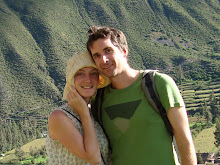 From Potosí, we spent 6 bumpy hours on a bus bouncing through the mountains in rain on muddy dirt tracks. We were relieved to get off the bus, but our destination, the small desert town of
From Potosí, we spent 6 bumpy hours on a bus bouncing through the mountains in rain on muddy dirt tracks. We were relieved to get off the bus, but our destination, the small desert town of  Uyuni was built up in the 19th century around the Bolivian rail industry. It was to be a major interchange connecting
Uyuni was built up in the 19th century around the Bolivian rail industry. It was to be a major interchange connecting  Uyuni is a pretty depressing place. It lies on flat, barren land and the outskirts are strewn with abandoned plastic bags and rubbish that packs of wild dogs pick over in the evenings. All of the streets are unnecessarily wide, presumably because they expected the town to one day be a major centre of commerce, and poorly lit at night. Most of the buildings are one storey, stretched houses made of mud bricks with tin roofs. The place is awash with backpackers who come here to go on tours of the nearby Salt Flats. There are over 50 tour operators, 15 pizza restaurants and not a lot else. The mornings are a hive of activity as backpackers are sorted out into jeeps and packed off for a few days. It’s like a ghost town then until the next load of tourists flood into town in the evenings.
Uyuni is a pretty depressing place. It lies on flat, barren land and the outskirts are strewn with abandoned plastic bags and rubbish that packs of wild dogs pick over in the evenings. All of the streets are unnecessarily wide, presumably because they expected the town to one day be a major centre of commerce, and poorly lit at night. Most of the buildings are one storey, stretched houses made of mud bricks with tin roofs. The place is awash with backpackers who come here to go on tours of the nearby Salt Flats. There are over 50 tour operators, 15 pizza restaurants and not a lot else. The mornings are a hive of activity as backpackers are sorted out into jeeps and packed off for a few days. It’s like a ghost town then until the next load of tourists flood into town in the evenings.We stayed in Uyuni for an extra day before out Salt Flats tour to sort out our robbery insurance claim. We spent a great few hours at the train cemetery, and heading back into town, bumped into an Easter parade that the whole town had turned out for. A ceramic Jesus was carried through town in a glass coffin/case to the fourteen stations of the cross set up along a central avenue. Uyuni is a pretty strange place. I can’t imagine what it would be like to live here. I think unless you were born here it would be difficult to adapt to it. We were relieved after our Salt Flats tour to be on the night train out of Uyuni and to head down to the Argentine border.
Uyuni is a pretty strange place. I can’t imagine what it would be like to live here. I think unless you were born here it would be difficult to adapt to it. We were relieved after our Salt Flats tour to be on the night train out of Uyuni and to head down to the Argentine border.

No comments:
Post a Comment